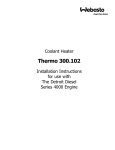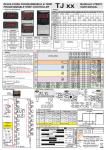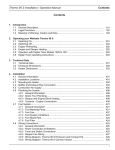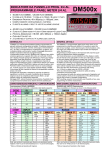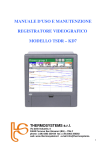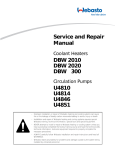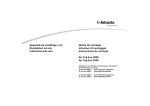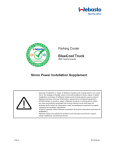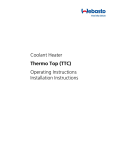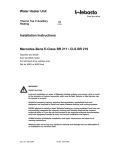Download Webasto Thermo 230 Operating instructions
Transcript
Coolant Heaters Thermo 230.036 Thermo 300.066 Diesel - 24 Volts Installation Instructions Operating Instructions 07/2012 P/N 907507 Thermo 230/300 Contents Contents 1. Introduction 1.1 General Description......................................................................................................... 1.2 Legal Provisions .............................................................................................................. 1.3 Meaning of Warning, Caution and Note .......................................................................... 101 102 102 2. Operating your Webasto Heater 2.1 Switching On.................................................................................................................... 2.2 Switching Off.................................................................................................................... 2.3 Engine Pre-heating.......................................................................................................... 2.4 Boost Heating for Engine and Passenger Compartment ................................................ 2.5 Operation with 7-Day Digital Timer Model 1531.............................................................. 2.6 7-Day Digital Timer Programming and Operating Instructions........................................ 201 202 202 202 202 204 3. Technical Data 3.1 Thermo 230/300 Heater Data.......................................................................................... 3.1.1 Thermo 230/300 Heater Dimensions.................................................................... 3.2 Coolant Circulation Pump Data ....................................................................................... 3.2.1 Coolant Circulation Pump Dimensions ................................................................. 301 302 303 303 4. Installation 4.1 General Information......................................................................................................... 4.2 Installation Location......................................................................................................... 4.3 Mounting the Heater ........................................................................................................ 4.4 Exhaust Pipe Connection ................................................................................................ 4.5 Combustion Air Supply .................................................................................................... 4.6 Plumbing Into the Coolant System .................................................................................. 4.6.1 General Information .............................................................................................. 4.6.2 Engine and Passenger Compartment Heating ..................................................... 4.6.3 Example of a Heater Installation in a Bus............................................................. 4.7 Fuel System..................................................................................................................... 4.7.1 General Description .............................................................................................. 4.7.2 Fuel Supply ........................................................................................................... 4.7.3 Fuel Filter .............................................................................................................. 4.8 Wiring Connections ......................................................................................................... 4.8.1 General Information .............................................................................................. 4.8.2 Timer and Switch Connections ............................................................................. 4.8.3 Timer and Switch Installation................................................................................ 4.8.4 Wiring Diagram - with Switch ................................................................................ 4.8.5 Wiring Diagram - with 7-Day Digital Timer Model 1531........................................ 4.9 Initial Operation................................................................................................................ 401 401 401 401 402 403 403 403 406 407 407 407 408 409 409 409 409 410 411 412 I Thermo 230/300 Contents 5. Maintenance of the Heater 5.1 Annual Maintenance........................................................................................................ 501 6. Basic Troubleshooting 6.1 General Information ......................................................................................................... 6.2 Operational Failure Symptoms (Reading the flash code) ............................................... 6.2.1 Reading a Fault Code with 1531 “Comfort” Timer Installed ................................ 6.2.2 Storing a Fault Code in Memory ........................................................................... 6.3 Operational Failure Symptoms via Fault/Flash Code...................................................... 6.4 Reading and Removing Fault Codes Stored in Memory with PC Diagnostics Kit .......... 601 601 602 602 603 604 7. Warranty Policy 8.1 Warranty Policy................................................................................................................ 801 List of Figures 101 201 301 302 303 304 401 402 403 404 405 406 407 408 409 410 II Webasto Thermo 230/300 Heater ................................................................................... 7-Day Digital Timer – Model 1531 ................................................................................... Thermo 230/300 Heater Dimensions .............................................................................. Coolant Circulating Pump Assembly - U 4814 ................................................................ Coolant Circulating Pump Assembly - U 4851 ................................................................ Pump Operating Data - U 4851 ....................................................................................... Series Plumbing Circuit (Shown with heater installed).................................................... Parallel Plumbing Circuit (Shown with heater installed) .................................................. Engine Preheat/Boost Heating Circuit ............................................................................. Example of Heater Installation......................................................................................... Fuel Standpipe Installation .............................................................................................. Fuel Line Parameters ...................................................................................................... On/Off Switch................................................................................................................... 7-Day Digital Timer Model 1531 ...................................................................................... Wiring Diagram with Switch............................................................................................. Wiring Diagram with Timer .............................................................................................. 101 203 302 303 304 304 404 404 405 406 407 408 409 409 410 411 Thermo 230/300 Contents List of Tables 201 301 302 601 Digital Timer Instructions ................................................................................................. Thermo 230/300 Heater Data.......................................................................................... Coolant Circulation Pump Data ....................................................................................... Operational Failure Symptoms via Fault/Flash Code...................................................... 204 301 303 603 PART # 907 507 Rev. 11.15.98 Subject to modification III Thermo 230/300 1 1. Introduction 1.1 General Description 1 2 3 4 5 6 Combustion air fan Motor Electronic control unit Electronic ignition coil Ignition electrodes Water pipes 7 8 9 10 11 12 Fuel nozzle Temperature sensor Overheat thermostat Heat exchanger Combustion chamber Combustion air swirler 13 14 15 16 17 Introduction Exhaust pipe 18 Fuel supply / return Photo disc 19 Coupler Flame detector 20 Combustion air intake Fuel pump w/ solenoid valve Combustion air adjusting shutter Fig. 101: Webasto Thermo 230/300 Heater The Webasto Thermo 230 and 300 Heaters for use on diesel powered transit buses and coaches are designed to: 1. Preheat Engine block of liquid cooled engines to ensure reliable starting in cold weather and to reduce cold start wear and emissions (white smoke). 2. Boost heating levels with the engine running. The heater will boost the heating system in cold weather when an engine is running at light loads, even at high speeds or idling. The heat rejection of modern diesel engines to the coolant, especially in buses, is often not adequate to heat the vehicle’s interior. 3. Increase Driver Visibility in poor weather conditions by providing higher levels of heat for quick defrosting/defogging of windshield and side glass. 101 1 Thermo 230/300 Introduction 1.2 Legal provisions Heater installation must be performed in accordance with the manufacturer`s installation instructions. Any deviations from these instructions are only permitted with written approval from Webasto Thermosystems. Installations not complying with the installation instructions will release Webasto Thermosystems from any product liability. OEM installations must be approved by Webasto Thermosystems. 1.3 Meaning of Warning, Caution and Note WARNING This heading is used to highlight that noncompliance with instructions or procedures may cause accidents leading to severe injury or death. 102 CAUTION This heading is used to highlight that noncompliance with instructions or procedures may cause damage to equipment. NOTE This heading is used to highlight and draw specific attention to information. Thermo 230/300 2. 2 Operating your Webasto Heater Operating your Webasto Heater Before switching the Webasto water heater on, set vehicle heating system to the “heat” position and open any shut off valves. Depending on the type of control installed in the of the vehicle, the heater can be operated by the following methods. 2.1 Switching On Using a timer: WARNING Due to the danger of poisoning and asphyxiation the heater must not be operated in enclosed spaces such as garages or workshops without adequate exhaust extraction. Using a switch: WARNING The heater must be switched “OFF” while refueling and at fueling stations. Timer Switch Upon actuation of the “instant heat” button the “operation indicator” on the timer lights up. Or WARNING Do not operate any Webasto heater in an area where toxic or explosive materials or fumes may be present. When the switch is used for switching “ON” the Webasto heater, the operation indicator integrated in the switch is illuminated. The heater motor and coolant circulating pump begin to run. After approximately 10-25 seconds the solenoid valve opens and fuel is sprayed into the combustion chamber. At the same time, the electronic ignition coil produces high voltage (8000 V) and the mixture of fuel and air in the combustion chamber is ignited by a spark produced at the tip of the ignition electrodes. The flame is detected by the photo cell, then the electronic ignition coil stops producing high voltage and combustion continues by itself (spark on electrodes is only required to ignite the flame). At this point the heater is working and produces heat. The Webasto heater will cycle on and off until: 1. The Webasto heater is switched off. 2. Time has elapsed on the timer. 3. The vehicle battery voltage drops below 20.0V. 4. The Webasto heater runs out of fuel. 5. A fault lock out occurs, indicated by the operating indicator light being off during the cool down cycle (i.e. overheat). 201 2 2.2 Operating your Webasto Heater Switching Off When heating is no longer required, switch the Webasto heater off. The solenoid valve interrupts the fuel supply, combustion stops and the indicator light turns off. The Combustion air fan and the water pump remain on for another 2-3 minutes (after run cycle) purging the combustion chamber of any fumes. 2.3 Engine Pre-heating 1. Set the timer 30 min. to 1 hr. before you want to start engine. The heater will start up at set time. (See timer operating instructions beginning on page 203). Or switch the toggle switch or “instant on” switch on your timer in the vehicle dash to “ON”. The heater will start up. 2. When time is elapsed on your timer or engine preheat is no longer required, switch the Webasto heater “OFF”. The heater will go through the after-run cycle. 2.4 Boost Heating for Engine and Passenger Compartment 1. Switch the toggle switch (or the “instant on” button of the timer) in the vehicle dash to “ON”. The heater will heat the coolant to a temperature of 185°F (85°C). Above this temperature only the water pump will run. 2. When boost heating is no longer required, switch the Webasto heater “OFF”. The heater will begin a brief after-run (cool-down) cycle. 2.5 Operation with 7-Day Digital Timer Model 1531 The “Digital Timer with 3 time settings” permits the Webasto heater to be switched on and off instantly, or automatically at 3 programmable starting times. The operating time of the heater can be pre-selected. It is possible to program 3 different heating programs according to your individual needs. Only one preset starting time can be activated at any one time. When the vehicle’s ignition is switched on, the current time of the day and the day of the week are displayed. 202 Thermo 230/300 NOTE Restarting the Webasto during the after-run period is allowed. Thermo 230/300 2 Operating your Webasto Heater Programmed Heater Operation Three memory locations numbered 1 to 3 are available. Each memory location can be assigned a given time together with the day of the week. Pre-selected Starting Times The pre-selected starting time is the time at which the heater switches itself on automatically. We recommend that memory locations 1 and 2 be used for presetting starting times within 24 hours of setting the timer. Memory location 3 can be used for a starting time within the next 7 days of setting the timer. Operating Time The period of time during which the heater is in operation is referred to as operating time. The heater remains in operation for as long as the operating time has been preset. Heater operation can be pre-selected for any time from as little as 1 minute to a maximum of 120 minutes (factory preset is 60 minutes). Remaining Operating Time The remaining operating time refers to the period of time the heater still continues to remain in operation. It can only be changed while heater is in operation. NOTE If the ignition is switched off while the heater is in operation, the remaining operating time of 5 minutes flashes on the display and the heater continues to operate for this period of time. Setting the Digital Timer After the power has been connected, all symbols on the digital display are flashing. The time of the day and the day of the week must be set. All flashing displays and symbols of the timer can be set by means of the and buttons. If the buttons are not pressed within 5 seconds, the currently displayed time or function will be stored. When the and buttons are pressed for more than 2 seconds, the quick digit advance mode is activated. Fig. 201: 7-Day Digital Timer – Model 1531 203 2 2.6 Operating your Webasto Heater 7-Day Digital Timer Programming and Operating Instructions Setting the time and day of the week Press the button for more than 2 seconds. Time display flashes. Press the or button to set time of day. Wait 5 seconds. Time is now stored. Day of week flashes. Press or button to set day of week. Wait 5 seconds. Day of week is now stored. Viewing the time With ignition “ON”: Continuous display of current time and day of the week. With ignition “OFF”: Briefly press button. Display of current time and weekday appears for 5 seconds. Switching heater on for instant heater operation With ignition “ON”: Press button. Heater is switched on (continuous heating) and continues to operate until button is pressed again or ignition is switched off. With ignition “OFF”: Press button. Heater is switched on for the preset operating time (the factory-set heater operating duration is 60 minutes). Switching the heater off Press button. Heater starts its after-run cycle and is switched off thereafter. Programming heater starting time Press button. Memory location number flashes. Press or button to preset starting time. Wait 5 seconds. Preset starting time is now stored. Day of week flashes. Press or button to set day of week. Wait 5 seconds. Day of week is now stored. The number of memory location remains on the display. The timer is now in the programmed mode and switches heater on at the preset time. Recalling pre-selected times Press button until the desired memory location number is displayed. Read off preset time. Canceling pre-selected times Press button repeatedly until no more memory location number is visible on the display. Programming duration of operating time The heater must be switched off. Press the button. Operating time flashes. Press or button to set operating duration time (between 1 and 120 minutes). Setting the remaining operating time Heater must be in operation. Press button. Remaining operating time flashes. Press or button to set remaining operating time. Wait 5 seconds. Remaining operating time is now stored. Table 201: Digital Timer Instructions 204 Thermo 230/300 NOTE If the ignition is switched off while the heater is in operation, the remaining operating time of 5 minutes flashes on the display and the heater continues to operate for this period of time. NOTE We recommend that memory locations 1 and 2 be used for presetting starting times within 24 hours of setting the timer. Memory location 3 can be used for a starting time within the next 7 days of setting the timer. By repeatedly pressing button, starting time 1, 2 or 3 can be preset. Thermo 230/300 3 3. Technical Data 3.1 Thermo 230/300 Heater Data Thermo 230 Heater Thermo 300 Coolant Heater with High Pressure Fuel Nozzle Design Heat Output BTU/hr (kW) 80,000 (23) 104,000 (30) Diesel #1, Diesel #2, Arctic and Kerosene Fuel Fuel Consumption max. Technical Data Kg/hr (US. gal/hr) 2.5 (0.8) 3.3 (1.2) Rated Voltage (V) 24 Operating Voltage (V) 20 ... 28 Power Consumption without Water Pump (W) 65 110 Permissible Ambient Temperature during Operation °C (°F) -40 ... +60 (-40 ... +140) Storage Temperature °C (°F) +85 max. (+185 max.) Minimum Capacity of Cooling System l (US. gal) Permissible Operating Pressure of Coolant CO2 in Exhaust Gas bar (psi) % by Volume Dimensions of Heater L W H mm (inch) Weight of Heater including Control Unit kg (lb) 10.0 (2.64) 0.4 ... 2.0 (06 ... 29) 10.5 ±0.5 610 mm (24.01 in.) 246 mm (9.69 in.) 220 mm (8.66 in.) 19 (41.88) Table 301: Thermo 230/300 Heater Data 301 3 3.1.1 Technical Data Thermo 230/300 Heater Dimensions Fig. 301: Thermo 230/300 Heater Dimensions 302 Thermo 230/300 Thermo 230/300 3.2 3 Technical Data Coolant Circulation Pump Data U 4814 U 4851 5200 (22.9) against 0.2 mbar 6000 (26.4) against 0.4 mbar Circulating Pump Flow Rate l/hr l/h (gal/min) Rated Voltage (V) 24 24 Operating Voltage Range (V) 20 ... 28 18 ... 32 Power Consumption (W) 104 209 221 mm (8.7 in.) 100 mm (3.94 in.) 105 mm (4.14 in.) 285 mm (11.22 in.) 115 mm (4.52 in.) 110 mm (4.33 in.) mm (inch) O.D. 38.0 (1.5) 38.0 (1.5) kg (lb) 2.1 (4.63) 2.7 (5.95) Dimensions L W H mm (inch) Hose connection Weight Table 302: Coolant Circulation Pump Data 3.2.1 Coolant Circulation Pump Dimensions Fig. 302: Coolant Circulating Pump Assembly - U 4814 303 3 Technical Data Fig. 303 Coolant Circulating Pump Assembly - U 4851 Fig. 304 Pump Operating Data - U 4851 304 Thermo 230/300 Thermo 230/300 4. Installation 4.1 General Information Webasto will take you step by step through the installation process to ensure successful operation for years to come. The installation must be performed in accordance with the installation instructions provided in this manual. 4 Installation NOTE This manual does not cover all possible installations. For special applications use this manual as a general guideline only. Contact Webasto Thermosystems directly at 1-800-555-4518. IMPORTANT! The proposed heater installation must be approved by Webasto Thermosystems. 4.2 Installation Location The heater and circulation pump are to be integrated into the coolant system (or into a separate heating circuit, if applicable) of the vehicle. The heater should be installed as low as possible in the coolant system to assure static bleeding of the heater and the circulating pump. The heater is to be installed in a clean and dry environment, usually a separate compartment, accessible for service, typically towards the rear of the vehicle. The heater may also be located in the engine compartment. The installation enclosure must provide adequate ventilation for combustion air requirements [4 in² (20 cm²)]. When installing the heater, make certain that the clearances required for accessing the unit for servicing are observed (e.g. removal of the combustion chamber). See figure 301, page 302. 4.3 WARNING The heater must not be installed in either the driver’s compartment or in the passenger area of vehicles. NOTE The circulating pump is not self priming. Mounting the Heater 1. Drill all required holes to dimensions shown in figure 301, page 302. 2. Bolt heater rigidly inside enclosure or engine compartment. 4.4 Exhaust Pipe Connection Rigid exhaust pipe is recommended in installations where the use of an exhaust deflector is not suitable. The exhaust pipe must have a minimum internal diameter no less than 2 3/4" (70mm) and a length no greater than 16’ (5m). The pipe may have several bends totaling no more than 270° overall. Do not cut and weld pipe to make 90° angled corners. WARNING Exhaust pipes must be so routed that the possibility of exhaust fumes entering the vehicle is unlikely. 401 4 Installation 1. Install exhaust deflector on heater exhaust outlet or install exhaust pipe. 2. Route the exhaust system so that the possibility of discharged exhaust gasses entering the vehicle is prevented. 3. Direct the discharge opening of the exhaust system in such a way as not to be pointed in the direction of travel, and so located that the possibility of clogging caused by snow, mud or debris is prevented. 4. Any condensation water collecting in the exhaust pipe must be discharged. If necessary, drill a drain hole at the lowest point to allow drainage. 4.5 NOTE Route the exhaust system away from any parts of the vehicle that may be damaged by heat (i.e., brake lines, electrical wiring, hoses and fuel lines). NOTE Additional flexible exhaust tubing Webasto part number 479 721. Combustion Air Supply Never draw combustion air from inside the passenger area of a vehicle, or from areas where fumes and gasses can accumulate. Where heater is installed in a sealed compartment, adequate ventilation for combustion air requirements [4 in² (20 cm²)] must be provided. Combustion air can be drawn from a remote (protected) area in order to provide a clean air supply. For installations requiring remotely drawn combustion air, use approved ducting with an unrestricted internal diameter no less than 2 1/4" (55mm) and a length no greater than 16’ (5m). The ducting may have several bends totaling no more than 270° overall. Approved combustion air ducting can be ordered through Webasto under part number 887 29A. To connect combustion air intake ducting [2 1/4" (55mm)] to the heater, several types of fittings are available that snap directly onto the combustion air inlet of the heater. For a straight connection, order a straight adapter under part number 101 377 and snap it onto the combustion air inlet and attach air ducting. In the event there is insufficient room for a straight attachment, a 90° snap-on fitting (P.N. 101 404) and an adapter ring (P.N. 823 15A) are available. Simply snap them onto the combustion air inlet of the heater and attach ducting. For installations where ducting is not required, the heater is factory equipped with a splash deflector that simply snaps onto the combustion air inlet. 402 Thermo 230/300 WARNING Never draw combustion air from inside the vehicle, or from areas where fumes or gases can accumulate CAUTION Combustion air ducting must be non-restrictive. Do not connect to existing vehicle air ducting or filtration systems. NOTE Approved combustion air ducting can be ordered under Webasto part number 887 29A. Thermo 230/300 4.6 Plumbing Into the Coolant System 4.6.1 General Information An efficient heating system must have an adequate supply of hot water to all heater cores. The amount of hot water available to a typical three or more heater core system depends on the water pumps capability and the amount of restriction within the coolant system. 4 Installation WARNING When working on the coolant system, allow the engine to cool down and open the radiator cap carefully. Webasto high performance circulating pumps designed for extensive heating applications are available. Installing a Webasto heater and circulating pump in accordance with the following instructions will maximize the heating systems efficiency. Coolant typically is routed out of the engine, through the Webasto coolant heater and then through the vehicle’s heating system. A path for coolant flow must always be maintained while the Webasto heater is in operation. A bypass loop will be required if an uninterrupted coolant flow path cannot be assured due to valves being closed while the Webasto heater is in operation. The coolant circulating pump(s) must operate while the Webasto heater is “ON.” The coolant circulating pump must be mounted as low as possible in the vehicle’s cooling system. A minimum of 10% of a good quality antifreeze should be maintained in the cooling system at all times. Heater and water pump fit 1.5” (38 mm) I.D. heater hose meeting SAE 20 R3 specifications. Silicone hose requires special hose clamps. 4.6.2 Engine and Passenger Compartment Heating CAUTION The Webasto heater relies on coolant flow to transfer heat from the heater to the vehicle’s heating system. The coolant pump(s) must be operating and there must be a path for coolant to flow or the heater will overheat. NOTE Heater hose must meet SAE 20 R3 specifications. Silicone hose requires special hose clamps. Hose clamps must be tightened to 45 in/lb. (5 Nm) torque. A: Heater Cores arranged in Series (fig. 401) A series heating system works in this fashion: Heated water (coolant) from the engine travels through the first heater core in the circuit, then on to the next heater core in circuit, and on to the next, etc. Each core adds some restriction, resulting in decreased water flow. Not only is water flow reduced, but also water temperature is reduced by each successive heater core resulting in the last core receiving water that is usually too cool to be effective. 403 4 Installation Thermo 230/300 Fig. 401: Series Plumbing Circuit (Shown with heater installed) B: Heater Cores arranged in Parallel (fig. 402) A parallel heating system works in this fashion: Heated water (coolant) from the engine travels through a common supply and return circuit, but unlike a series system, the heater cores are connected across the circuit at intervals along its length. Each core shares the available coolant and heat equally, resulting in increased heating efficiency and decreased coolant restriction. Fig. 402: Parallel Plumbing Circuit (Shown with heater installed) A fuel fired Webasto heater used in conjunction with a high capacity coolant pump can significantly increase the available heat and coolant volume supplied to both series and parallel systems increasing interior heating efficiency. With the addition of a timer, the above systems can also provide pre-heating capability. 404 CAUTION A path for coolant to flow must be provided whenever the Webasto heater is operating. CAUTION Water pump(s) must be operating when the Webasto heater is in operation.. Thermo 230/300 C: Engine pre-heating and/or Boost Heating Only (fig. 403) This type of installation is used where engine pre-heating and or system boost heating is the primary requirement. The heater can be installed across the heating circuit before any of the vehicle heating cores or installed independently of the vehicles heating circuit by plumbing directly from and returning back into the engine. Depending on how the Webasto heater is controlled (timer, switch, vehicle system), heat can be supplied for engine pre-heating and maintaining higher operating temperatures. Interior heating efficiency will be enhanced by the higher operating temperatures provided by boost heating. 4 Installation WARNING When working on the coolant system, allow the engine to cool down and open the radiator cap carefully. Fig. 403: Engine Preheat/Boost Heating Circuit Instructions for options A, B or C (Typical installations) On typical systems, the coolant supply will originate at the engine. From there, it will travel through the supply hose to the Webasto coolant pump (or vehicle manufacturer supplied boost pump), through the pump and into the fuel fired heater where the coolant is heated during operation. The heated coolant then leaves the heater at the outlet and continues on through the vehicles heating system and returns to the engine. 1. Identify the type of system you are working with to determine the appropriate type of installation as shown in figures 401, 402 or 403. - find and identify heating circuit supply hose. This is the starting point for determining the type of plumbing configuration you will choose. 2. Connect heater into the system according to the examples shown in figures 401, 402 or 403. NOTE Silicone hose requires special hose clamps. NOTE Heater hose must meet SAE 20 R3 specifications. NOTE Hose clamps must be tightened to to 45 in/lb. (5 Nm) torque. 405 4 4.6.3 Installation Example of a Heater Installation in a Bus Fig. 404: Example of Heater Installation 406 Thermo 230/300 Thermo 230/300 4.7 Fuel System 4.7.1 General Description 4 Installation NOTE The heater is equipped with an internal self priming fuel pump. The fuel is drawn from the vehicles fuel tank through a fuel standpipe. This standpipe can be utilized on vehicles with a spare threaded port as shown in figure 405. The Webasto heater utilizes 37° flare JIC fuel connection fittings. The fuel supply line fitting is a JIC #4 and the return line is a JIC #6. 4.7.2 Fuel Supply IMPORTANT! Keep the submerged end of fuel standpipe at least 2" from bottom of fuel tank. The fuel standpipe and fuel line must be installed according to these instructions to insure proper heater operation. CAUTION If the fuel tank is higher than the Webasto heater, the top of the tank may not be more than 20" above the heater. Fig. 405: Fuel Standpipe Installation 1. Cut fuel standpipe to length, approx. 2" off fuel tank bottom. 2. Install the fuel standpipe. NOTE After fuel standpipe has been cut to length, remove any burrs. 407 4 Installation - use 1/4" or 1/2" spare port on fuel tank (if available) and install fuel standpipe securely in fuel tank, use pipe thread sealant on all pipe threads. 3. Route and secure fuel lines from heater to fuel tank. Route according to applicable regulations. Use grommets to protect fuel lines whenever routed through holes. 4. Connect fuel lines to fuel standpipe and heater using 1/4" (6 mm) I.D. fuel line. Steel braided fuel lines are recommended for installations where the heater is located in the engine compartment. Thermo 230/300 CAUTION Fuel line must be secured every 12" and kept away from hot exhaust and moving parts (drive shaft, wheels, etc.). Fig. 406: Fuel Line Parameters A = Suction height 6’6" (2,0 m) A+B = Suction length and height not to exceed 33’ (10 m) 4.7.3 Fuel Filter The heater must be equipped with a fuel filter. Fuel filters require changing at least annually and in cases of dirty fuel more often. The fuel filter assembly should be mounted near the heater. After installation, before the heater is fired for the first time, the fuel system and filter will require priming. In most cases, this will be achieved by turning on the heater and allowing it to self prime. In some cases the fuel filter may require filling with CLEAN diesel fuel before installation to assist system priming. 408 NOTE Change the fuel filter at least annually. CAUTION To prevent fuel nozzle failure, always use CLEAN fuel from a known CLEAN source for priming fuel systems and filters. Thermo 230/300 4.8 Wiring Connections 4.8.1 General Information The control unit is equipped with low voltage protection, therefore it is imperative to keep vehicle batteries in good condition. Thermo 230/300 heaters are available in 24 volt configurations only. 4.8.2 Timer and Switch Connections 4 Installation NOTE The Webasto heating system will not perform to your satisfaction with weak batteries. CAUTION If welding is done on the vehicle, the main battery cables must be disconnected from the battery to protect the electronic control unit. Fig. 407: On/Off Switch Fig. 408: 7-Day Digital Timer Model 1531 4.8.3 Timer or Switch Installation 1. Select a suitable location in the vehicle for the timer or On/Off switch. 2. Connect the harness to the timer, or switch. 409 Installation Wiring Diagram - with Switch X4 C A B BROWN RED 4.8.4 BLACK 4 Fig. 409: Wiring Diagram with Switch 410 Thermo 230/300 Thermo 230/300 Installation BLACK X4 C A B RED Wiring Diagram - with 7-Day Digital Timer Model 1531 BROWN 4.8.5 4 Fig. 410: Wiring Diagram with Timer Model 1531 411 4 4.9 Installation Thermo 230/300 Initial Operation 1. Check your installation for: - loose nuts and bolts. - exhaust pipe routing and clamp tightness. - loose hose clamps. - routing and securing of wiring and heater hoses. - kinked or pinched hoses. - battery connection and polarity. 2. Top off or refill cooling system with coolant as per engine manufacturers recommendations. 3. Open shut-off valves and driver’s heater valve. 4. Set vehicle heater controls to maximum heat position. 5. Start the vehicle engine and run it at a fast idle for 10 minutes to purge air from the Webasto coolant heater and all of the heat exchangers. While the engine is running check: - hose connections for leaks. - coolant level in the expansion tank and add coolant as needed. - use bleeder valve on top of Webasto heat exchanger to purge out trapped air when necessary. 6. Switch on Webasto heater and check: - indicator light on. - circulating pump in operation. - heater fan motor in operation. - presence of combustion after approximately 25 seconds. 7. Shut off the engine. 8. Allow heater to run until coolant is hot and heater cycles off. During this period, monitor system for any coolant or fuel leaks. 9. Temperature differential between water inlet and outlet should not exceed 10° C (18° F) during heating operation. 10. Switch “OFF” Webasto heater. 11. Re-tighten hose clamps to 45 in/lb. (5 Nm) and inspect installation for leaks. 14. Install any panels and access covers removed during installation. 412 NOTE Installation with long fuel lines may need a second start attempt to initially prime the fuel system. Cycle ON/OFF switch or timer to reset control unit. NOTE Coolant temperature must be below 158°F (70°C) to start up. Thermo 230/300 15. Complete the warranty card and send to Webasto Thermosystems (There is an area on the last page of this manual for recording information which is useful when calling for technical support). 16. Install the compartment cover if equipped. Installation is now complete. 4 Installation NOTE The engine temperature gauge may read a lower temperature depending on the location of the temperature sensor on the engine. NOTE Necessary information to complete warranty card and ensure full warranty coverage can be found on name plate. 413 Thermo 230/300 5. Maintenance of the Heater 5.1 Annual Maintenance 5 Maintenance of the Heater The Webasto heater requires a minimum of maintenance to operate. To keep your heater in service the following maintenance procedures should be performed annually before each heating season: Enclosure Area - clean the heater and enclosure area from any accumulated debris or dust with compressed air - inspect all components for wear and damage Electrical System - check wiring harnesses for damage, fix or replace if required - check condition of the batteries and connections. - load test batteries and replace if necessary. NOTE For major repairs and spare parts, return to your authorized Webasto Thermosystems servicing Specialist. NOTE The heater will not function properly with weak batteries. Exhaust System - check the exhaust system carefully for restrictions or corroded areas. Replace exhaust pipe if necessary. Fuel System - change fuel filter and inspect fuel lines for wear and damage. Repair or replace if necessary. Burner System - swing open burner head, clean flame detector (photo eye), pull out combustion chamber and inspect and clean heat exchanger. Replace nozzle if necessary (annually). Re-install combustion chamber and close up burner head. Operation Test - Run your heating system for at least 15 minutes. - Check water and fuel connections for leakage. Re-tighten clamps and fittings if necessary. NOTE Operate your Webasto at least once a month for 20 minutes. 501 Thermo 230/300 6. Basic Troubleshooting 6.1 General Information 6 This section describes troubleshooting procedures for the Thermo 230/300 coolant heater. Troubleshooting is normally limited to the isolation of defective components. Before troubleshooting, check for and eliminate these defects: - fuel supply (plugged fuel filter) - corrosion on battery terminals - blown fuses - corrosion on electrical wiring, connections and fuses - loose contacts, or improper crimping on connectors - shut down initiated by temperature limiter thermostat (automatic reset) 6.2 Basic Troubleshooting CAUTION Troubleshooting requires profound knowledge about structure and theory of operation of the heater components and should only be performed by skilled personnel. NOTE After any correction of a defect a functional test has to be performed in the vehicle. NOTE Coolant temperature must be below 158°F (70°C) to start up. Operational Failure Symptoms (reading the flash code) A flash code will be generated on the indicator light of the control (on / off) switch in the event of an operational failure. In order to make a correct analysis it’s necessary to understand the flash code event. The flash code event is only visible during the after run (cool down) period of operation. During the flash code event you will see the following: Five quick flashes followed by a slower sequence of flashes, the slower sequence of flashes is the actual fault code. The first five quick flashes are only an indication that a fault code has been registered and will be displayed. Count only the slower sequence of flashes to obtain the current fault code. For example (flashes = ¤): Fault code 7X (F 07): ¤¤¤¤¤ ... ¤ ... ¤ ... ¤ ... ¤ ... ¤ ... ¤ ... ¤ The flash code sequence will be repeated during the Thermo 230/300 after run (cool down) period and will remain visible once heater stops in the lock out mode. Once the heater is cycled “OFF” and “ON” the fault code will no longer be visible on the indicator light but will be stored in memory. 601 6 6.2.1 Basic Troubleshooting Reading a Fault Code with 1531 “Comfort” Timer Installed Where the Thermo 230/300 installation includes the model 1531 “Comfort” Digital Timer, you will be able to read the current failure fault code directly from the timer display. The flame indicator symbol will “flash” the present fault code once and will then convert the fault code to an alphanumeric display message. For example: fault code 10 (overheat) will be visible on the timer display as “F 10". Once the failure has been corrected, and the heater switch or timer is cycled ”OFF" and “ON” and the heater successfully starts and runs with no further failures, the error code will disappear from the timer display. 6.2.2 Storing a Fault Code in Memory Once the Thermo 230/300 completes the after run (cool down) period initiated by a failure event, the current flash code will be downloaded (stored) in memory. The Thermo 230/300 can store up to ten fault codes. Once the memory is “full”, any additional fault code will replace the earliest code stored thereby continually updating the fault codes stored in memory with the four most recent faults. 602 Thermo 230/300 CAUTION Troubleshooting requires profound knowledge about structure and theory of operation of the heater components and may only be performed by skilled personnel. NOTE After any correction of a defect a functional test has to be performed in the vehicle. Thermo 230/300 6.3 6 Basic Troubleshooting Operational Failure Symptoms via Fault/Flash Code The following table lists the possible faults which can be read by flashing code or read directly off of an appropriate timer or with the PC diagnostics kit. Failure Symptom Probable Cause Check and Correct 1X Flash (F 01) No combustion after completion of start up sequence. - Fuel system - Fuel level - Type of fuel being used - Fuel filter - Fuel line connections (air bubbles in fuel lines) - fuel nozzle plugged - Air intake or exhaust, restricted or plugged - incorrect electrode gap - Combustion air - Electronic ignition 2X Flashes (F 02) Flame out during burner operation no restart possible - Fuel supply (shortage of fuel) - Restriction in the fuel system - Fuel filter - Fuel line connections (air bubbles in fuel lines) - Type of fuel being used 3X Flashes (F 03) Low voltage for more than 20 seconds - Electrical system - Load test batteries - Corrosion at connections - Loose connections 4X Flashes (F 04) Flame detector recognizes false flame signal during pre-start or shut-down cycle - Defective flame detector - Replace flame detector 5X Flashes (F 05) Flame detector - Wiring - Defective flame detector - Damaged wiring, open or short circuit - Replace flame detector 6X Flashes (F 06) Temperature sensor - Wiring - Defective temperature sensor - Damaged wiring, open or short circuit - Replace temperature detector 7X Flashes (F 07) Fuel solenoid valve - Wiring - Defective solenoid valve - Damaged or corroded wiring, open or short circuit - Replace solenoid valve 8X Flashes (F 08) Combustion air fan motor - Wiring - Wrong RPM - Defective combustion air fan motor - Damaged wiring, open or short circuit - Replace combustion air fan - Replace combustion air fan 9X Flashes (F 09) Circulation pump motor - Wiring - Defective circulation pump motor - Damaged wiring, open or short circuit - Replace circulation pump motor 10X Flashes (F 10) Temperature limiter - Overheat condition - Coolant flow - Defective temperature limiter - Reset temperature limiter - Coolant level or flow restriction - Air trapped in coolant circuit - Damaged or corroded wiring, open or short circuit - Replace temperature limiter 11X Flashes (F 11) Electronic ignition coil - Wiring - Defective electronic ignition coil -Damaged wiring, open or short circuit -Replace electronic ignition coil 12X Flashes (F 12) Heater lock out 3 repeated faults/flame-outs or 5 repeated start attempts Reinitialize control unit by switching heater on and disconnecting power. - Wiring Table 601: Operational Failure Symptoms (Control Unit SG 1572 D) 603 6 6.4 Basic Troubleshooting Reading and Removing Fault Codes Stored in Memory with the Webasto PC Diagnostics Kit and Adapter It is possible to read and remove (reset) stored fault codes from the Thermo 230/300 memory. This is achieved through the use of a diagnostic interface kit connected to the Thermo 230/300 and an IBM compatible computer having the necessary software installed. The PC Diagnostic Interface Kit comes with software and instructions for use with Webasto heaters equipped with internal diagnostics capabilities such as the Thermo 230/300. Order PC Diagnostics Kit under part number 925 42A and adapter under part number 208 65A. System requirements: • IBM compatible PC with 80286 processor or higher • DOS version 3.0 or higher including *MS Windows (*Not required) • at least 1 MB RAM • hard disk with at least 3 MB space available • 3 1/2 inch, 1.44 MB floppy disk drive for installation of program files • VGA graphics board with 640 x 480 pixel resolution and at least 16 colors • unused serial port • monitor, keyboard (mouse or other pointing device recommended) In addition to working with stored fault codes, the PC Diagnostics Kit allows you to do several other functions such as reading values while the heater is in operation or testing individual components. Printing out of fault codes is also available (User supplied printer required). For further capabilities and detailed instructions for use with the Thermo 230/300 heater, see instruction manual supplied with the PC Diagnostics Kit. 604 Thermo 230/300 CAUTION Diagnostics equipment is intended for use by Webasto trained personnel at authorized Webasto Distributor, Dealer and End User service facilities. 7 WARRANTY POLICY * Thermo 230/300 7. WARRANTY POLICY * Webasto Thermosystems Inc. and Webasto Thermosystems (Canada) Ltd., (herein after referred to as “Webasto”) warrants their products and related component parts against defects in materials and workmanship for 24 months effective from installation date or vehicle registration date for O.E.M. installations. The warranty period may not however, exceed 36 months from the original date of delivery by Webasto. During the warranty period the EXCLUSIVE REMEDY will be for Webasto to repair or replace those parts which are demonstrated to be defective in material or workmanship. In the event of a defect covered by this warranty, only Webasto authorized distributors/dealers are permitted to perform warranty work. Call Webasto @ 1-800-Heater-1 (1-800-432-8371) or, in Canada @ 1-800-667-8900 for your closest Webasto authorized dealer. Please complete and return the Webasto warranty registration card immediately upon installation or registration of new vehicle. Webasto specifically excludes and limits from warranty the following: • Normal wear of service parts including: Fuel nozzles, filters and fuses. • Improper installation, which is not in accordance with valid supplied installation instructions. • Deterioration, due to normal wear and tear, corrosion, abuse, damage, accident, improper storage or operation. • Modification, of a product by alteration, use of non genuine parts or repair by unauthorized personnel. • Economic loss, for expenses related to travel, vehicle disassembly, personal injury or other incidental or consequential damages. * See official warranty for complete details 801 Webasto Product N.A., Inc. 15083 North Road Fenton, MI 48430 Technical Assistance Hotline USA: (800) 555-4518 Canada: (800) 667-8900 Org. 10/1998 Rev. 07/2012 P/N 907507 www.webasto.us www.techwebasto.com




































